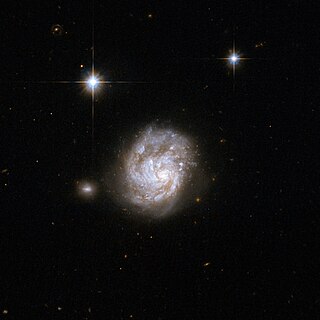
NGC 695 is a spiral galaxy located 450 million light years from the Earth, in the constellation of Aries. It has been described as an abnormal galaxy, and has the appearance of "a revolving tornado". Its arms are not tightly held together, and it is interacting with another small astronomical object. Despite its distance of nearly 0.5 billion lightyears, the galaxy's extremely luminous starburst disk, bright IR and UV emissions earned it a spot in the NGC catalogue. VLASS 1.2 survey images indicate the presence of extended radio emission in the core of the galaxy- indicative of either an active SMBH, nuclear starburst, or both.

NGC 6090 is a merging pair of spiral galaxies, 400 million light-years from the Earth, in the constellation of Draco. The cores of the two galaxies are around 10,000 light-years apart from each other, meaning that the merger is likely at its intermediate stage. Two large "tails", made of galactic material gravitationally ejected during the merger, have formed outside the main galaxies. Newly formed stars can be seen in the overlapping area.

LEDA 83677 is a lenticular galaxy located about 290 million light-years away in the constellation Coma Berenices. It is a member of the Coma cluster of galaxies. LEDA 83677 is also classified as a type 1 Seyfert galaxy. The core of the galaxy is emitting high-energy X-rays and ultraviolet light, probably caused by a massive black hole lurking in the core.
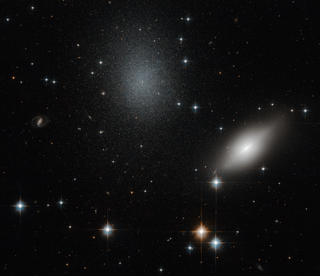
NGC 5011 is an elliptical galaxy in the constellation of Centaurus. It was discovered on 3 June 1834 by John Herschel. It was described as "pretty bright, considerably small, round, among 4 stars" by John Louis Emil Dreyer, the compiler of the New General Catalogue.

NGC 4488 is a lenticular galaxy located about 60 million light-years away in the constellation of Virgo. The galaxy was discovered by astronomer William Herschel on December 28, 1785. NGC 4488 is a member of the Virgo Cluster.
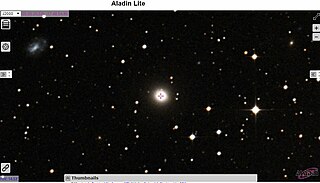
NGC 1993 is a lenticular galaxy located in the Lepus constellation. It was discovered by John Herschel on February 6, 1835. It is about 143 million light years from the Milky Way. Its apparent magnitude is 13.39 and its size is 1.5 arc minutes.

NGC 3840 is a spiral galaxy located about 320 million light-years away in the constellation Leo. The galaxy was discovered by astronomer Heinrich d'Arrest on May 8, 1864. NGC 3840 is a member of the Leo Cluster. The galaxy is rich in neutral atomic hydrogen and is not interacting with its environment.

NGC 3861 is a large barred spiral galaxy with a ring-like structure located about 310 million light-years away in the constellation Leo. It was discovered by astronomer John Herschel on March 23, 1827. NGC 3861 is a member of the Leo Cluster and has a normal amount of neutral hydrogen and ionised hydrogen.
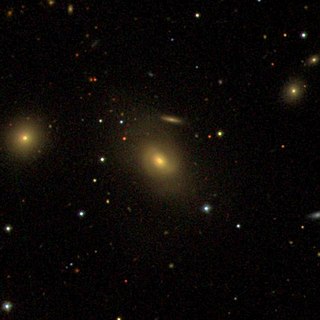
NGC 6055 is a barred lenticular galaxy located about 450 million light-years away in the constellation Hercules. The galaxy was discovered by astronomer Lewis Swift on June 8, 1886. It also a member of the Hercules Cluster and is a LINER galaxy.

NGC 3558 is an elliptical or a lenticular galaxy located 440 million light-years away in the constellation Ursa Major. It was discovered by the astronomer Heinrich d'Arrest on April 15, 1866. It is a member of the galaxy cluster Abell 1185 and is classified as a LINER galaxy.

NGC 688 is a barred spiral galaxy with starburst activity located 190 million light-years away in the constellation Triangulum. It was discovered by astronomer Heinrich d'Arrest on September 16, 1865 and is a member of the galaxy cluster Abell 262.

NGC 704 is a lenticular galaxy located 220 million light-years away in the constellation Andromeda. The galaxy was discovered by astronomer William Herschel on September 21, 1786 and is also a member of Abell 262.

NGC 7837 is a spiral galaxy located about 470 million light-years away in the constellation of Pisces. The galaxy was discovered by astronomer Albert Marth on November 29, 1864. NGC 7837 appears to interact with NGC 7838 forming Arp 246.

NGC 7838 is a spiral or lenticular galaxy located about 500 million light-years away in the constellation of Pisces. The galaxy was discovered by astronomer Albert Marth on November 29, 1864. NGC 7838 appears to interact with NGC 7837 forming Arp 246.
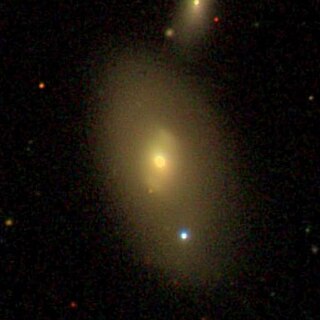
NGC 4296 is a barred lenticular galaxy located about 200 million light-years away in the constellation Virgo. It was discovered by astronomer William Herschel on April 13, 1784. It forms a pair with NGC 4297, and both galaxies are listed as CGCG 042-041, and KPG 331.

NGC 4297 is a lenticular galaxy located about 200 million light-years away in the constellation Virgo. It was discovered by astronomer William Herschel on April 13, 1784. It forms an interacting pair with NGC 4296.

NGC 970 is an interacting galaxy pair in the constellation Triangulum. It is estimated to be 471 million light-years from the Milky Way and has a diameter of approximately 100,000 ly. The object was discovered on September 14, 1850 by Bindon Blood Stoney.

NGC 3937 is an elliptical or a lenticular galaxy located about 310 million light-years away in the constellation Leo. It was discovered by astronomer William Herschel on April 27, 1785 and is classified as a radio galaxy.

NGC 3925 is a barred lenticular galaxy and a ring galaxy located about 370 million light-years away in the constellation Leo. It was discovered by astronomer Heinrich d'Arrest on February 19, 1863.
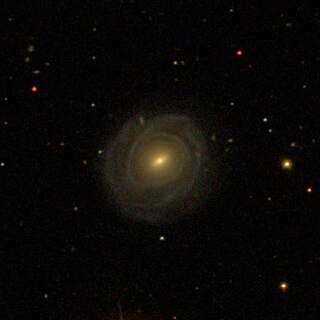
NGC 4326 is a barred spiral galaxy with a ring located about 330 million light-years away in the constellation Virgo. It was discovered by astronomer William Herschel on April 13, 1784, who described it as "vF, S, R, bM, 1st of 3". It is a large galaxy, with a diameter of around 200,000 ly (61 kpc) making it nearly twice the size of the Milky Way. NGC 4326 is also classified as a LINER galaxy. Despite being listed in the Virgo Cluster catalog as VCC 623, it is not a member of the Virgo Cluster but instead a background galaxy.




















